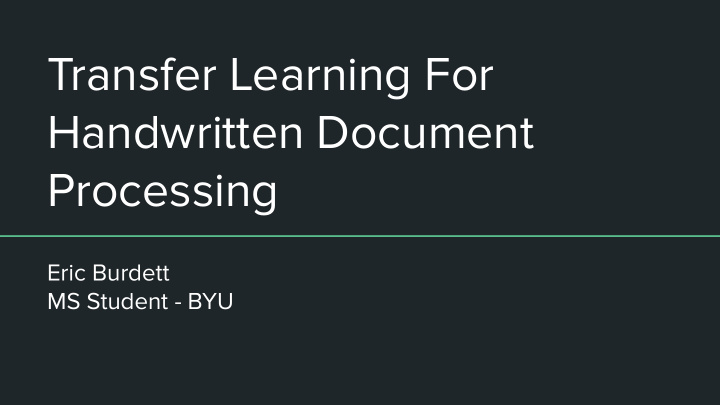



Transfer Learning For Handwritten Document Processing Eric Burdett MS Student - BYU
Start-Follow-Read ● End-to-End Full-Page Handwriting Recognizer [3] Start of Line ○ ○ Line Follower Recognition ○ ● Won 2017 ICDAR Competition on Handwritten Text Recognition
Start-Follow-Read - Does it Generalize? 1: Thursday, May 9, 1889 6: Georgie Webber, Mose Thatcher and girl 1: TUPSAAY, 6: Beorgie Welhr, Mon Thatcher md giel 2: Went to Salt Lake to attend a 7: Walt. Jennings, mr Teasdale. and others 2: Went to salt lake to attend a 7: Walt, Zinmngs, Mr. Seardeli and others 3: party given a Eldridge’s. There was 8: It fell to my lot to take the 3: parlyy gione a Adridgio. There was 8: Io fell to my lot to tatre the 4: present kate a Celia Sharp Katie 9: Webber’s home. 4: purent Nate Celia Pharf Ialie 9: Weblrrs home. 5: B Young Mel Sharp, Lottie and 10: Stayed at Eldriges that eve. 5: B. Youngmel Charf, Loe 10: Stayed as Elaridges that en.
Start-Follow-Read - Does it Generalize? 0: Airi 1: D 2: Chaloge & 3: B
ARU-Net ● State-of-the-Art Baseline Detection [4] Deep U-Net (with residual units) ○ ○ Spatial Attention Mechanism Winner of the 2019 ICDAR Competition on Baseline Detection ●
ARU-Net - Does it Generalize?
ARU-Net - Does it Generalize?
The Point ● Incredible performance with enough labeled data Performance decreases as target domain differs from source domain ● ● Labeling data is costly ● Where do we go from here?
Transfer Learning ● The process of utilizing knowledge gained from one task and applying it to another related problem. [12]
Types of Transfer Learning [7]
Inductive Transfer Learning ● Labeled data in source and target domains. ● Fine-tune on pretrained model ● Potential Benefits Better Accuracy ○ ○ Faster Training Fewer Labeled Data in Target ○ Domain [7]
Transductive Transfer Learning ● Labeled data in source, Unlabeled data in target ● Access to unlabeled target data during training ● Potential Benefits Better accuracy ○ ○ Less/No labeled data needed in target domain ○ Align the feature representations in the source and target domains [7]
Feature Representation Transfer ● Identify good feature points that apply to both the source and target domain [10]
Feature Representation Transfer Labeled Data Unlabeled Data [10]
Domain Adversarial Training SYN Numbers → SVHN Blue → Source Activations [9] Red → Target Activations
Domain Adversarial Training [1]
CycleGAN [5]
CycleGAN [13]
CycleGAN
CycleGAN - Chinese Characters SIMHEIM SIMHEIM Generated Characters Generated Characters Font Font [2]
Other Transductive Transfer Learning Ideas ● Self-Supervised Learning [6] Fine-Tune model on images from the target set that classified with high confidence ○ ● Style-Transfer [11] ○ Apply handwriting style from target set to source set as pre-processing step
Looking Forward ● Expand on transductive transfer learning for handwriting recognition Apply these techniques using a source domain other than a system font ● ○ Tibetan Characters [1] ○ Chinese Characters [2] ● The Goal: Produce a system that utilizes the power of transfer learning to achieve good performance on unlabeled datasets
References [1] S. Keret, L. Wolf, N. Dershowitz, E. Werner, O. Almogi and D. Wangchuk, "Transductive Learning for Reading Handwritten Tibetan Manuscripts," in 15th International Conference on Document Analysis and Recognition , Sydney, Australia, 2019. [2] B. Chang, Q. Zhang, S. Pan and L. Meng, "Generating Handwritten Chinese Characters using CycleGAN," in Winter Conference on Applications of Computer Vision (WACV) , Lake Tahoe, NV/CA, 2018. [3] C. Wigington, C. Tensmeyer, B. Davis, W. Barrett, B. Price and S. Cohen, "Start, Follow, Read: End-to-End Full-Page Handwriting Recognition," in European Conference on Computer Vision , Munich, Germany, 2018. [4] T. Gruning, G. Leifert, T. Straub, J. Michael and R. Labahn, "A Two Stage Method for Text Line Detection in Historical Documents," International Journal on Document Analysis and Recognition (IJDAR), vol. 22, no. 3, pp. 285-302, 2019. [5] J.-Y. Zhu, T. Park, P. Isola and A. A. Efros, "Unpaired Image-to-Image Translation using Cycle-Consistent Adversarial Networks," in International Conference on Computer Vision (ICCV) , Venice, Italy, 2017. [6] V. Frinken and H. Bunke, "Evaluating Retraining Rules for Semi-Supervised Learning in Neural Network Based Cursive Word Recognition," in 10th International Conference on Document Analysis and Recognition , Barcelona, Spain, 2009.
References [7] S. J. Pan and Q. Yang, "A Survey on Transfer Learning," IEEE Transactions on Knowledge and Data Engineering, vol. 22, no. 10, pp. 1345-1359, 2010. [8] J. Yosinski, J. Clune, Y. Bengio and H. Lipson, "How transferable are features in deep neural networks?," in Advances in Neural Information Processing Systems (NIPS) , Montreal, Canada, 2014. [9] Y. Ganin, E. Ustinova, H. Ajakan, P. Germain, H. Larochelle, F. Laviolette, M. Marchand and V. Lempitsky, "Domain-Adversarial Training of Neural Networks," Journal of Machine Learning Research, vol. 17, no. 1, pp. 1-35, 2016. [10] U. V. Marti and H. Bunke, "A full English sentence database for off-line handwriting recognition," in Proceedings of the 5th International Conference on Document Analysis and Recognition , Bangalore, India, 1999. [11] R. Gomez, A. F. Biten, L. Gomez, J. Gibert, M. Rusinol and D. Karatzas, "Selective Style Transfer for Text," in Proceedings of the 15th International Conference on Document Analysis and Recognition , Sydney, Australia, 2019. [12] D. Sarkar, "A Comprehensive Hands-on Guide to Transfer Learning with Real-World Applications in Deep Learning," Towards Data Science, 14 November 2018. [Online]. Available: https://towardsdatascience.com/a-comprehensive-hands-on-guide-to-transfer-learning-with-real-world-applications-in-deep-lear ning-212bf3b2f27a. [Accessed 20 February 2020].
References [13] R. Vijay, "Image-to-Image Translation using CycleGAN Model," Towards Data Science, 14 November 2019. [Online]. Available: https://towardsdatascience.com/image-to-image-translation-using-cyclegan-model-d58cfff04755. [Accessed 22 February 2020].
Recommend
More recommend